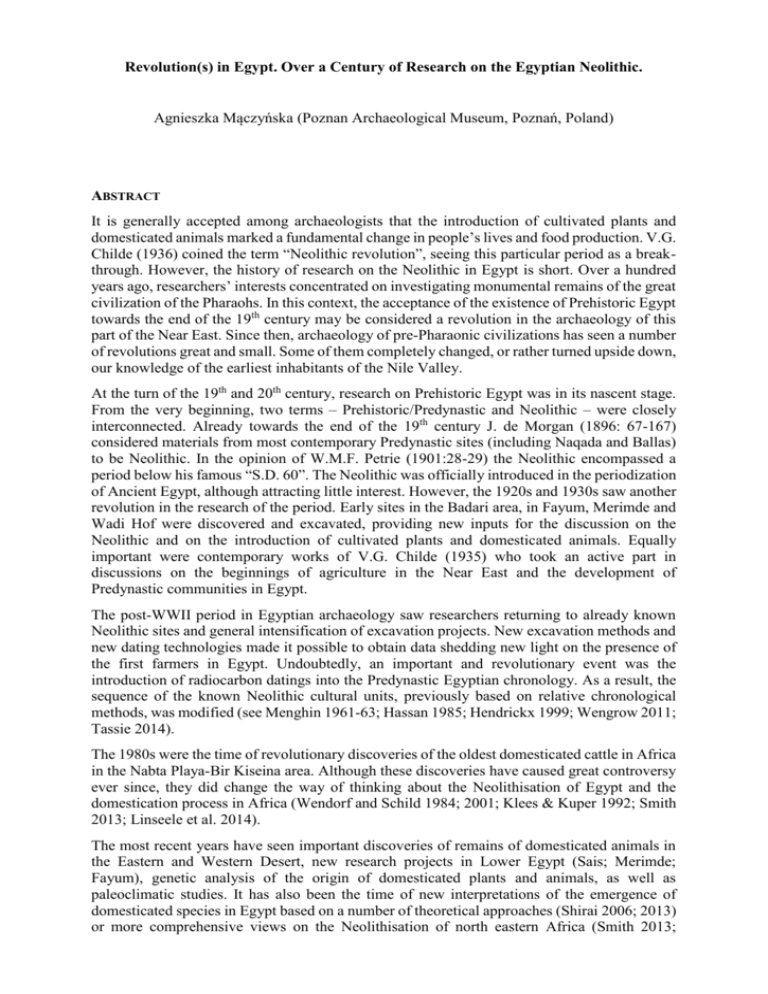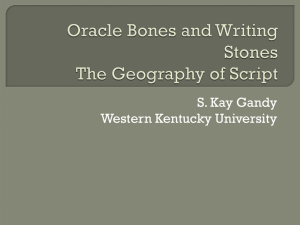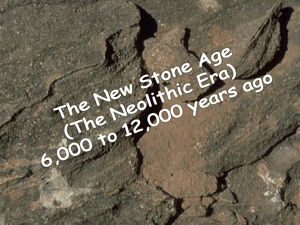Agnieszka Mączyńska
advertisement

Revolution(s) in Egypt. Over a Century of Research on the Egyptian Neolithic. Agnieszka Mączyńska (Poznan Archaeological Museum, Poznań, Poland) ABSTRACT It is generally accepted among archaeologists that the introduction of cultivated plants and domesticated animals marked a fundamental change in people’s lives and food production. V.G. Childe (1936) coined the term “Neolithic revolution”, seeing this particular period as a breakthrough. However, the history of research on the Neolithic in Egypt is short. Over a hundred years ago, researchers’ interests concentrated on investigating monumental remains of the great civilization of the Pharaohs. In this context, the acceptance of the existence of Prehistoric Egypt towards the end of the 19th century may be considered a revolution in the archaeology of this part of the Near East. Since then, archaeology of pre-Pharaonic civilizations has seen a number of revolutions great and small. Some of them completely changed, or rather turned upside down, our knowledge of the earliest inhabitants of the Nile Valley. At the turn of the 19th and 20th century, research on Prehistoric Egypt was in its nascent stage. From the very beginning, two terms – Prehistoric/Predynastic and Neolithic – were closely interconnected. Already towards the end of the 19th century J. de Morgan (1896: 67-167) considered materials from most contemporary Predynastic sites (including Naqada and Ballas) to be Neolithic. In the opinion of W.M.F. Petrie (1901:28-29) the Neolithic encompassed a period below his famous “S.D. 60”. The Neolithic was officially introduced in the periodization of Ancient Egypt, although attracting little interest. However, the 1920s and 1930s saw another revolution in the research of the period. Early sites in the Badari area, in Fayum, Merimde and Wadi Hof were discovered and excavated, providing new inputs for the discussion on the Neolithic and on the introduction of cultivated plants and domesticated animals. Equally important were contemporary works of V.G. Childe (1935) who took an active part in discussions on the beginnings of agriculture in the Near East and the development of Predynastic communities in Egypt. The post-WWII period in Egyptian archaeology saw researchers returning to already known Neolithic sites and general intensification of excavation projects. New excavation methods and new dating technologies made it possible to obtain data shedding new light on the presence of the first farmers in Egypt. Undoubtedly, an important and revolutionary event was the introduction of radiocarbon datings into the Predynastic Egyptian chronology. As a result, the sequence of the known Neolithic cultural units, previously based on relative chronological methods, was modified (see Menghin 1961-63; Hassan 1985; Hendrickx 1999; Wengrow 2011; Tassie 2014). The 1980s were the time of revolutionary discoveries of the oldest domesticated cattle in Africa in the Nabta Playa-Bir Kiseina area. Although these discoveries have caused great controversy ever since, they did change the way of thinking about the Neolithisation of Egypt and the domestication process in Africa (Wendorf and Schild 1984; 2001; Klees & Kuper 1992; Smith 2013; Linseele et al. 2014). The most recent years have seen important discoveries of remains of domesticated animals in the Eastern and Western Desert, new research projects in Lower Egypt (Sais; Merimde; Fayum), genetic analysis of the origin of domesticated plants and animals, as well as paleoclimatic studies. It has also been the time of new interpretations of the emergence of domesticated species in Egypt based on a number of theoretical approaches (Shirai 2006; 2013) or more comprehensive views on the Neolithisation of north eastern Africa (Smith 2013; Wengrow et al. 2014). However, our knowledge of the Neolithic and Neolithisation process in Egypt progresses at a pace that is slower than in the case of other issues involving the Near East (see Shirai 2006; 2013).We have to keep in mind the words of M. Zeder (2008), who treated north eastern Africa, including Egypt, as “an especially promising region for future research”. We need a new revolution: new discussions, new interpretations; and quite surely new, fresh revolutionary data is very much welcome….. REFERENCES: CHILD, V.G., 1935. New Light on the Most Ancient East. London. CHILD, V.G., 1936. Man Makes Himself. London. HASSAN, F. A., 1985. A radiocarbon chronology of Neolithic and Predynastic sites in Upper Egypt and the Delta. African Archaeological Review 3: 95-116. HENDRICKX, S., 1999. Le chronologie de la préhitoire tardive et des débuts de l’histoire de l’Egypte. ArcheoNil 9 : 13-81. KLEES, F. & KUPER R., 1992. New Light on the Northeast African past. Current Prehistoric Research. Köln. LINSEELE, V., VAN NEER, W., THYS, S., PHILLIPPS, R., CAPPERS, R., WENDRICH, W., HOLDAWAY, S., 2014. New Archaeozoological Data from the Fayum “Neolithic” with a Critical Assessment of the Evidence for Early Stock Keeping in Egypt. PLoS ONE 9(10: e108517. doi:10.1371/journal.pone.0108517. MENGHIN, O.F.A., 1961/63. Zur Chronologie des Neolithikum in Aegypten. Acta Praehistorica V/VII: 128-147. DE MORGAN, J., 1896. Recherches sur les origines de l’Egypte. I. L’age de la pierre et des métaux. Paris. PETRIE, W.M.F., 1901. Diospolis Parva, the cemeteries of Abadiyeh and Hu, 1898-9. London. TASSIE, G.J., 2014. Prehistoric Egypt. Socioeconomic Transformations in North-east Africa from the Last Glacial Maximum to the Neolithic, 24,000 to 6,000 cal BP. London. SHIRAI, N., 2006. Supra-regional Concepts in Near Eastern Neolithisation from Viewpoint of Egyptian Neolithic Research, Paléorient 32/2: 7-21. SHIRAI, N., 2013 Was Neolithisation a struggle for existence and the survival of the fittest, or merly the survival of the luckiest? A case study of socioeconomic and cultural changes in Egypt in the Early-Middle Holocene [in:] SHIRAI, N. (ed.), Neolithisation of Northeastern Africa. Berlin: 213-235. SMITH, A., 2013. An appraisal of the terms ‘Neolithic” and ‘Neolithisation’ for use in BNorth Africa in the 21st century in:] SHIRAI, N. (ed.), Neolithisation of Northeastern Africa. Berlin: 522. WENDORF, F. & SCHILD, R., 1984. Conclusion [in:] Wendorf, F., Schild, R. & Close, A.E., (eds.), Cattle-keepers of the Eastern Sahara: the Neolithic of Bir Kiseiba. Dallas: 404-428. WENDORF, F. & SCHILD, R., 2001. Conclusion [in:] Wendorf, F. & Schild, R. (eds.). Holocene settlement of the Egyptian Sahara. Vol. 1. The Archaeology of Nabta Playa. New York: 648675. WENGROW, D., 2006. The Archaeology of Early Egypt: Social Transformation in North-East Africa, 10,000 to 2650 BC. Cambridge. WENGROW, D., DEE, M., FOSTER, S., STEVENSON, A. & BRONK RAMSEY, CH., 2014. Cultural convergence in the Neolithic of the Nile Valley: a prehistoric perspective on Egypt’s place in Africa. Antiquity 88: 95-111. ZEDER, M., 2008. Domestication and early agriculture in the Mediterranean basin: Origins, diffusion, and impact. PNAS 105:11597-11604.







